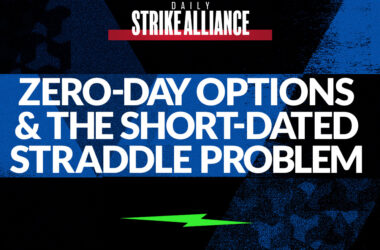Good morning, traders…
Ben here.
Options trading is about making informed bets.
You must identify a potential directional move and a timeframe when it could happen — then, bet on it.
It’s a bit like sports betting on the stock market (with far more access to information).
However, many traders ignore one of the most important aspects of making options bets, which often leads to their downfall…
I’m talking about probability — the likelihood that a particular event will occur.
Traders use various models to estimate these probabilities, helping them make more informed decisions.
Like any other bet, options contracts have “odds” of success, which market makers use to determine prices.
In options trading, the probability of an option expiring in the money (ITM) is particularly important.
If your contracts have a low probability of expiring ITM, they’ll be a lot less expensive than their counterparts with a higher probability of success.
That said, those contracts will also increase by a greater % if they do reach their strike price.
I’ll tell you the hard truth: It will be nearly impossible to make money in this volatile market if you don’t understand the probability relationship between option prices and their underlying stocks.
With that in mind, let me show you everything you need to know about probability in options trading…
What Are the Greeks?
I’m not talking about Zeus, Apollo, or Poseidon…
The Greeks — delta, gamma, theta, and vega — are four measurements that show how the price of the underlying stock affects the options contracts you trade.
Moreover, they’re specifically designed to help you understand the probability of your bets.
Options pricing can be tricky. Contract prices can change a lot, even in a single day. And they don’t follow the share price exactly.
On the one hand, this volatility gives option contracts their high potential profitability.

On the other hand, it’s the same reason you can lose money FAST trading options (if you aren’t disciplined).
That’s why options traders have used the Greeks for years…
Each Greek focuses on a different part of options pricing, providing information about how your contracts will react in different price action scenarios.
The Greeks will help you gauge the probability of your options bets working (or not).
So, let’s define the Greeks to help make the options market less confusing (and potentially improve your trading)…
Delta
Delta compares how an options contract moves with the stock price.
It predicts how much the price of a contract will change if the stock price moves by $1.
Delta is shown as a number between -1 and 1.
A higher delta means the contract follows the stock price more closely.
Some weekly OTM contracts I trade will have a low, negative delta.
But this is why I’m careful with the options I choose. They’re risky, but they can also bring big profits.
Remember: Call options have a positive delta, while put options have a negative delta.
Gamma
Unlike delta, gamma is a % showing how much delta changes with the stock price.
Gamma goes up when a contract is in the middle of an options chain. It goes down for contracts that are deep in or out of the money.
In today’s market, gamma is linked with implied volatility (IV). This is clear in “gamma squeezes.”
A gamma squeeze is like a short squeeze on steroids. Traders buy low-delta, short-dated options, which pushes IV and gamma up.
This can dramatically increase the price of certain contracts, as seen in cases like the infamous Gamestop Corp. (NYSE: GME) and AMC Entertainment Holdings Inc. (NYSE: AMC) gamma squeezes of 2021.
In a gamma squeeze, options contracts can increase 1000% or more* as options buyers pressure market makers with higher and higher call prices.
(Had you understood gamma in March 2020, you might have been able to capitalize on the GME squeeze.)
Theta
If you’re considering selling options (or trading spreads), theta is important.
Theta shows how much a contract’s premium will decrease as it gets closer to expiration.
In other words, it helps traders judge the time decay of an option.
Theta is always negative because options lose value over time.
Generally, sellers want higher theta (more decay), while buyers want lower theta (less decay).
But, there’s no one-size-fits-all rule in options trading.
For example: Many of the weekly options I trade have high time decay and theta. But as long as I’m disciplined and stick to my rules, buying them still works for me.
Vega
Vega measures how much a contract’s price is subject to change in response to changes in IV.
Vega will be high if the underlying share price is close to the option’s strike price.
On the other hand, Vega lessens as we move further in or out of the money.
Vega also moves lower as the option nears expiration. This is because there’s less intrinsic value in the contract by that point in its life cycle.
The important thing to understand is the effect that vega has. If the vega is ramped on a stock, every option on the chain will increase in value.
Key Points to Remember
- The Greeks are valuable tools for understanding option prices…
- Start watching these values and note how they relate to your trading…
- Are you having more success when the Greeks on your contracts are at a certain level? Less when they are at others? Pay attention to these factors…
- Whether you’re selling or buying, or dealing with puts or calls, knowing the basics of these concepts is crucial to having long-term success in the options market…
How I Use ‘The Greeks’
I want to make sure the delta gives me enough upside and the theta doesn’t cost me too much downside.
Generally, I’m looking for a 3:1 relationship between delta and theta.
Understanding both probability and the Greeks allows traders to employ more nuanced strategies.
For example, a trader might use delta to gauge an initial position and then use gamma to adjust the position as the market moves.
Theta can inform decisions on the timing of trade exits, especially in short options positions where the trader benefits from time decay.
Additionally, traders might look at probability distributions and the Greeks to set up complex trades like spreads and straddles, which can minimize risk while providing profitable opportunities under varying market conditions.
Probability and the Greeks are fundamental to options trading. They provide a framework for evaluating risk and potential reward, helping you make decisions that align with your market outlook and risk tolerance.
The options market can be confusing, but I hope this helped you understand delta, gamma, theta, and vega better.
Spend time with these metrics, link them to your trading, and you might discover how they can drastically improve your options trading skills.
Now, before we go, let’s look at…
💰The Biggest Smart-Money Bets of the Day💰
- $5.12 million bearish bet on GDX 09/20/2024 $32 puts @ $1.71 avg. (seen on 5/3)
- $1.31 million bullish bet on AAPL 06/21/2024 $190 calls @ $3.65 avg. (seen on 5/3)
- $1.07 million bullish bet on PDD 05/31/2024 $160 calls @ $2.50 avg. (seen on 5/3)
Happy trading,
Ben Sturgill
P.S. This is your ONLY CHANCE to act on Jack Kellogg’s Next Big Trade…
Once this rare profit cycle begins, there’s no going back.
It’s why Jack’s discussing this next big trade, and giving away a second trade idea Thursday night, for FREE.
Jack’s top 28 trades have ALL generated 100% or higher — with 12 soaring over 250%, and 4 exploding beyond 600%.*
And the next one just might be Jack’s best trade ever…
Don’t miss it — CLICK HERE NOW BEFORE IT’S TOO LATE.
*Past performance does not indicate future results





